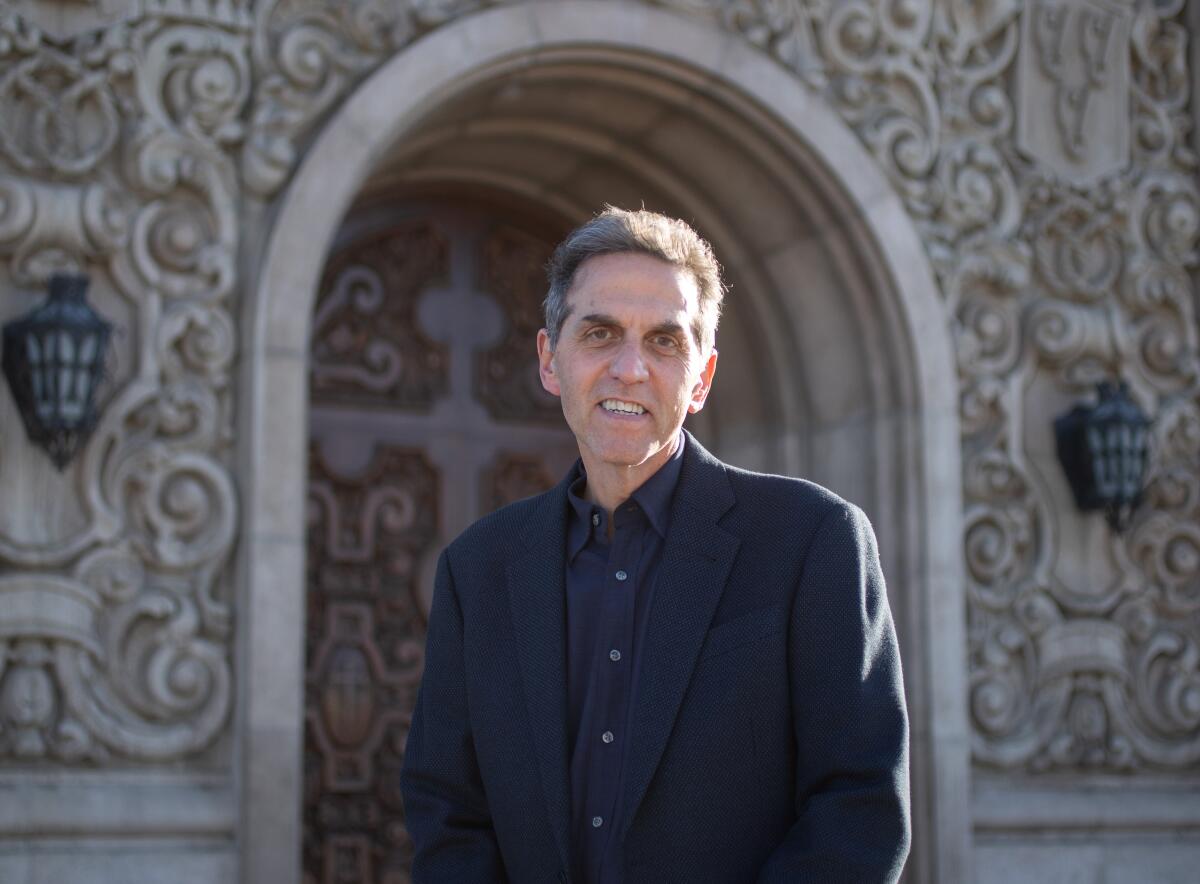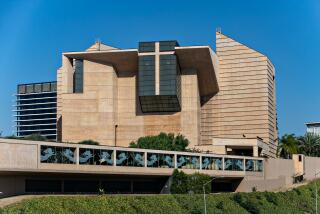How a retired L.A. television executive became publisher of the National Catholic Reporter

In his first column as publisher of the National Catholic Reporter, former television executive and journalist Joe Ferullo declared that the Roman Catholic Church is at a crossroads, pulled between two radically different visions for its future.
Writing in early December, Ferullo explained that a series of synods, or listening sessions, held in parishes around the world under the direction of Pope Francis had revealed a hunger among the faithful for a church that was more welcoming to its LGBTQ members and that allowed more opportunities for women to take on leadership roles.
And yet, in November, the U.S. Conference of Catholic Bishops had elected conservatives to nearly every important leadership role — including the group’s new president, Archbishop Timothy Broglio, who has served as archbishop for the military services since 2008. Experts who follow the church saw the election results as a pointed repudiation by the U.S. bishops of Pope Francis’ more inclusive vision.
“What path does the church take in the generations ahead? Does it expand the tent and reach out, or does it circle the wagons and close in?” Ferullo wrote. “It’s impossible to know where that path will lead by the end of 2024 — but these next two years could easily turn out to be the most decisive since Vatican II.”
As publisher of the 59-year-old National Catholic Reporter, where liberal voices have long held sway, Ferullo will have a front seat to the unfolding historic drama that could affect the church for years to come. And perhaps that explains why a guy three years into a comfortable retirement might decide to take on the anxiety and thrill of running the scrappy and beloved Catholic news organization.
“I thought about teaching,” he said. “But there’s not as much fun in that.”
He also believes that the future of the Catholic Church should be of interest not just to Catholics but to anyone who follows politics in America.
“Despite the fact that the church is shrinking in numbers in this country, it still has a lot of influence,” he said. “If you’re angry at Dobbs, then you’re angry at the group of Catholics who helped push that, including all those conservative Catholic Supreme Court justices,” he said, referring to the court case that overturned the constitutional right to an abortion.
Ferullo, 65, is warm and wiry with dark, graying hair. During an interview at a Le Pain Quotidien a short drive from his Studio City home, he described himself as a lifelong practicing Catholic.
He grew up in the late 1960s in a working-class neighborhood in the Bronx, N.Y., where his family belonged to a parish that fully embraced the reforms of Vatican II. Latin Masses were replaced with folk Masses that inspired him to learn to play guitar. The nuns at his parochial school removed their traditional habits, and his sixth-grade math teacher, Sister Maryann, occasionally taught the class Simon & Garfunkel songs instead of long division.
“It was a very cool time, especially as a kid,” he said. “And it’s what kept me Catholic even as things became more secular around me.”
But around 2008 he found himself growing angry with the church. Catholic bishops were attacking Obamacare over contraception coverage, calling it a religious liberty issue. At the same time, the Vatican began investigating American nuns out of concern that they were not acting Catholic enough. And although the church had recently started to confront its devastating sex abuse scandal, he was frustrated and disappointed that it had taken so long.
“It felt like the whole church was going, ‘You know that Vatican II thing we tried in the ‘60s? Let’s all forget about that,’” he said. “I felt very differently.”
A few years earlier, Ferullo had left a job as a producer for “Dateline” to become executive vice president of syndicated and daytime programs at CBS, where he oversaw shows such as “Judge Judy,” “Entertainment Tonight,” “Dr. Phil” and the “Rachael Ray” show.” He was also busy raising his two daughters in Studio City with his wife, Sylvia Lopez, a longtime news anchor for KCAL 9. Still, he made time to write a story about his personal experience of Vatican II and the positive effect it had on his life. He called it “When Vatican II came to the Bronx.”
The next step was to find someone to publish it.
“Secular media understandably doesn’t care enough, and a lot of traditional Catholic media run by archdiocese or religious orders would probably not touch it,” he said. Then he happened to meet Joe Feuerherd, the then-publisher of the National Catholic Reporter, at a networking brunch held by the L.A.-based Catholics in Media Assn. and told him about the piece.
“He said, ‘That sounds like us,’ and they published it,” Ferullo said. “It really meant a lot to me.”
Ferullo continued to write for NCR occasionally, and eventually joined the board in 2018. When his predecessor Bill Mitchell announced in May that he would be stepping down, Ferullo threw his hat into the ring to become the next publisher.
“There’s just something about the place that kind of gets in your blood and in your heart,” he said. “Progressive, social justice-oriented Catholicism doesn’t get a lot of attention today, thanks to some of the bishops. The fact that [NCR] still waves that flag and does great reporting about it is very attractive.”
The National Catholic Reporter was founded in 1964 by Robert Hoyt, a journalist who had mostly worked for diocesan newspapers and wanted to bring the rigor of secular journalism to the Catholic world. ‘’If the mayor of a city owned its only newspaper, its citizens will not learn what they need and deserve to know about its affairs,” he liked to say.
Headquartered in Kansas City, Mo., it was initially published as a weekly newspaper and its circulation grew from 11,000 to 100,000 in just a few short years. Its first big scoop occurred in April of 1967 when it revealed that Pope Paul VI had rejected a commission’s suggestion that the church’s teaching on birth control be revised. It was also the first publication to report on the clergy sex abuse crisis and the episcopal cover-up beginning in the 1980s, many years before the Boston Globe published its own investigation.
Today, NCR averages about 1 million unique visitors to its website per month and is still publishing a print newspaper that is sent out once every two weeks. In addition to reporting on the Vatican and the bishops, coverage areas include immigration, the environment and the influence of wealthy conservative Catholics on American politics.
“There are few Catholic media outlets that have done a better job covering the church with as much intelligence, independence and depth,” said John Gehring, Catholic program director at Faith in Public Life and an author who has written articles for the publication over the years. “It’s really an indispensable source for dogged reporting and informed commentary.”
One of Ferullo’s goals as publisher is to increase the paper’s coverage of Latino Catholics, who make up 40% of all U.S. Catholics. He also wants to expand coverage of Catholicism in the American West, where L.A. is home to the nation’s largest diocese.
“The Catholic Church has very strong roots in the Midwest and East Coast, and we’ve got that covered,” said Heidi Schlumpf, NCR’s executive editor since 2020. “But where the Catholic Church is growing is in the West and the Southwest. We know we have to do a better job of covering those areas.”
The National Catholic Reporter has never had a full-time reporter in California, and only recently hired its first West Coast-based reporter in Portland, Ore.
“Part of my sell was, you need someone in L.A.,” Ferullo said. “It’s the largest archdiocese in the country, and there are lots of progressive Catholics here. To not be in touch with what goes on on the West Coast is not right.”
As the outlet’s first L.A.-based publisher, Ferullo has been looking for local freelancers, especially those who speak Spanish, reaching out to local Catholic universities to learn more about their social justice efforts and trying to spread the word about the outlet to new readers and supporters. (Like PBS, NCR’s content is freely available and funded through individual donations.)
For now the publication is on solid financial ground, but many of its current supporters are older people who have been reading it since the days of Vatican II 60 years ago. In order to survive, it will need to find a new audience among younger Catholics.
While Pope Francis has energized progressive Catholics, his inclusive vision has also divided the church, nowhere more so than in the U.S., where L.A. Archbishop José Gomez has led the push to deny Holy Communion to President Biden, Nancy Pelosi and other Catholic politicians who support abortion rights. The pope has indicated that he disapproves of this practice, telling reporters that “Communion is not a prize for the perfect.”
Ferullo says the future of the church could also affect the future of NCR. If the pope is able to successfully energize younger progressive Catholics, he believes NCR will continue to survive for many years to come. If the more conservative faction wins out, however, he’s not so sure.
“Maybe you have another generation of disappointed, progressive Catholics who just give up,” he said.
More to Read
Sign up for Essential California
The most important California stories and recommendations in your inbox every morning.
You may occasionally receive promotional content from the Los Angeles Times.











